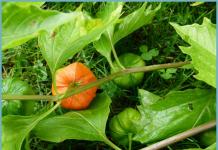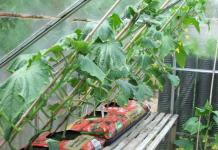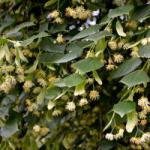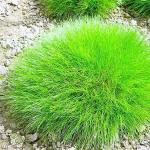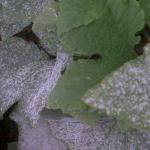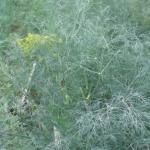Large-leaved linden
Large-leaved linden, or Broad-leaved linden, Flat-leaved linden, Summer linden (Tilia platyphyllos)
Species of the genus Linden (Tilia) of the family Malvaceae (Malvaceae); Previously, the genus Linden was usually distinguished into an independent family Linden (Tiliaceae).
The popular name is a lutoshka or a washcloth.
Tree up to 35 m in height.
The bark is dark gray or gray-brown, shallowly furrowed.
Young shoots are thick, reddish-brown, sparsely pubescent or glabrous.
The branches are protruding, ascending and diverging in rays, in the upper tier of the crown inclined downward. Kidneys oblong, glabrous, 4 - 5 mm long, 2.5 - 3 mm wide.

During flowering, it saturates the air with a pleasant honey aroma.
Large-leaved linden grows twice as fast as small-leaved linden, blooms two weeks earlier, and its leaves are 5 times larger. Annual growth in height 45 cm, width 35 cm.
It tolerates drought better, is more stable and durable in urban environments.
Linden is unpretentious, drought-resistant, shade-tolerant, grows slowly, is not damaged by insects and diseases. Demanding on the soil, prefers fertile substrates.

An excellent honey plant, and can significantly increase honey productivity. On 1 hectare of pure stands, this species can produce about 900 kilograms of nectar and 100 kilograms of pollen.
It is used for single plantings, for creating alleys and arrays, loves space, can be grown in the bonsai style.
If you want to enjoy the amazing smell of your blooming lindens for a longer time, plant large-leaved and small-leaved lindens nearby.
Winter-hardy from the latitude of St. Petersburg and to the south. Durable, can live up to 300 years.
In medicine, inflorescences, leaves, flowers of the plant are used.
Landing: Linden seeds must be stratified before sowing and this is done for 3-4 months in wet sand, wrapped in gauze and put in the refrigerator.

It can be planted in the spring both immediately in the ground (early May) and at home at any time, starting in February.
The method of sowing at home is even preferable, the seedlings turn out better, and as soon as the seedlings stretch up to 10-15 cm, they can be transplanted into the ground, either into the garden for further growing for 1-2 years, or to a permanent place.
The soil for sowing linden should be loose, ventilated, for this you can add a little peat or rotted sawdust. Also, gardeners often add sand to the ground in order to loosen it. The depth of seeding is 1-1.5 cm.
After sowing, the box is covered with foil and placed in a warm place. Seeds germinate in 2-3 weeks, then the film is removed, and the box is placed in a lighted place, usually on a windowsill on the sunny side.
As soon as the sprouts are sufficiently strengthened and gain strength, they should no longer be covered.
During the germination of linden seeds, the ambient air temperature should not be below 20C. Seedlings should receive enough sunlight to accelerate the process of photosynthesis.
Measures for the care of linden seedlings consist in the obligatory loosening of the soil layer and timely watering. After 3 weeks from the moment of emergence of seedlings, they must be thinned out in order to get rid of weak shoots.
Then all the resulting plants are planted in separate pots. This contributes to their further strengthening and growth. For this event, soil similar in composition to the one in which the seeds germinated is needed.
When transplanting seedlings, you need to carefully handle the root system, as it is still quite weak and can be damaged.
With the onset of real heat, which happens during the period of May, the seedlings obtained earlier are planted in an open area.
Synonyms: Linden flat-leaved; Linden; Tilia grandifolia Ehrh.; Tilia platyphyllos f. aurea (Loudon) Rehder; Tilia platyphyllos var. rubra (Weston) Rehder; Tilia rubra DC.
Type: Tilia platyphyllos is a deciduous tree.
Crown: dense, broad-pyramidal, with reddish-brown or coral, fluffy, rarely bare young shoots. Buds are reddish-brown, glabrous. Tree 20-30 m high, very old up to 40 m with a crown diameter of about 15 m.
Durability: over 100 years.
Growth rate: Grows moderately. Annual growth in height is about 40-50 cm.
vegetation: 6 months.
Trunk: Slender, with green-gray, smooth bark, becoming fissured, dark gray or gray-brown with age.
Branches: directed upwards and to the sides at wide angles, the shoots are flexible, bend easily without breaking. Young shoots and buds are reddish-green, slightly pubescent, red-brown in autumn, later dark gray.
Bark: Attractive grey-brown, finely fissured and furrowed and scaly
ridges.
Leaves: alternate, large, rounded-ovate with a sharp tip up to 14 cm, dark green above, glabrous, below - lighter and fluffy along the entire underside (distinctive feature), with tufts of light hairs in the corners of the veins, on petioles 2-6 cm .length. The leaves bloom two weeks later than the small-leaved linden. In autumn they are yellow. In hot weather, they can take on the appearance of a "hood" and crumble.
Flowers: yellowish-cream, larger than small-leaved linden, but less in inflorescence (2-5), blooms two weeks earlier than small-leaved linden, in early June. Valuable honey plant.
Fruit: Light green inflorescences, small, almost spherical, felt-pubescent nuts with
5 longitudinal scars and thick shell with sharp tips, accompanied by a long strap-like bract. The fruits are larger.
Roots: The root system is powerful, deep, taproot with far diverging lateral roots and a large number of fine superficial roots.
Requirements:
For illumination: sun, tolerates light shade.
To soil: Demanding on soil fertility, prefers fresh, fertile sandy loam and loamy soils. Does not tolerate salt content, weakly tolerates acids. On acidic, podzolic soils, the tap root practically does not develop. Adapts to alkaline soils.
For moisture: Prefers moderately moist, well-drained soils. Does not tolerate stagnant waterlogging, waterlogging. Sensitive to drought. In dry years, it reduces growth. Temporary lack and temporary excess of water endures.
Frost resistance: high Resistant to winter-spring temperature fluctuations; in some severe winters, freezing of shoots is possible, which does not affect the decorative effect of the tree.
Peculiarities: It has the narrowest of all varieties of large-leaved linden columnar crown. Wind-resistant, "Trash" by falling flowers, fruits and leaves. It retains its shape when cut, which allows it to be extended to create narrow walls. Enjoys great popularity. It tolerates shearing, shaping and pruning, so it is used to create sheared, hedges, green walls, trellises, and is also used in topiary art. Well restored after trimming, breakage, various damage. To maintain the crown in a decorative state, strong pruning is not required. Pruning is recommended once every 5 years. It is decorative with a wide pyramidal, highly arched, dense crown, red-brown shoots, larger than those of small-leaved linden, leaves, abundant fragrant inflorescences and fruits. Resistant to insect attack, but fungal problems anthraclose, thyrostromosis and verticulosis are possible.
Suitable for: mixed, tree - shrub groups, massifs, groves, individual specimens. Used in large parks and gardens as a solitaire, in avenue "mono" plantings, especially good for creating dense, trimmed hedges and walls, for regular and landscape gardens. It is used to create landscape compositions and contrasting combinations with plants in seasonal compositions. It tolerates urban conditions well, retains dust. Recommended for urban landscaping of streets, squares, intra-quarter, building and city courtyards, playgrounds and school
gardens, in the gardens of medical institutions. As a honey plant is used in plantings near apiaries.
Naturally grows in the forests of the western part of Ukraine, in Moldova, in the Caucasus, in Western (Denmark, the Netherlands, Belgium), Central (Austria, Czech Republic, Slovakia, Hungary, Poland, Switzerland) and Southern Europe (Turkey, Spain, France (including Corsica ), Italy, countries of the former Yugoslavia, Albania, Bulgaria, Greece, Romania).
The plants of each group are selected in such a way that any buyer can find not only familiar types and varieties of ornamental crops, but also novelties rarely found in nurseries that will delight him with unusual flowering, foliage ornament and crown shape. Our planting material can be used for landscaping city streets, parks, squares and adjacent territories.
As a manufacturer, we can guarantee a wide range of plants with consistently high quality plants, as well as affordable prices. The specialists of our nursery will provide qualified advice on the choice of plants, planting, maintenance and care of them.
Views: 4078
04.06.2018
In fact, a linden familiar to all of us (lat. Tilia) has many variations. Since the time of the Swedish biologist Carl Linnaeus, who created the famous plant classification system, over 350 different species, hybrids and varieties of this tree have been described. In his works, the scientist for the first time gave a description of the European linden, which is a natural hybrid of small-leaved ( lat. Tilia cordata) and flat-leaved or large-leaved ( lat. Tilia platyphyllos).
Plant characteristic
Linden belongs to deciduous plants with a powerful root system that penetrates deep into the soil. Trees can grow up to 600 or more years, while their height can reach more than forty meters, and the trunk diameter is as much as five.
The plant reproduces both by seeds and vegetatively.

Linden leaves in their shape resemble a heart with a pointed tip, and small triangular teeth are located along the edges of the leaf blade.
The flowers are usually yellow or cream in color, with a rich, pleasant fragrance that attracts bees. The fruits are small nuts with one or more grains inside.
Linden grows best in regions with a humid and warm climate and is very widely used for landscaping and decorating city and village parks and squares, since the tree has a beautiful spreading crown, is unpretentious in care and has a lot of useful properties.
Now few people remember, but in the ancient European tradition, linden has always symbolized the feminine, so household items, jewelry, dishes, shoes, and so on were made from this wood.
Linden is an excellent honey plant, and lime honey is rightfully considered one of the best and is highly valued because it has a powerful healing and healing effect.

It is noteworthy that according to the classical model of plant systematization developed by John Cronquist, linden has always been assigned to the Linden family ( lat. Tiliaceae), but the latest research by scientists in the field of genetics leaves no doubt that this family is more likely to belong to the Malvaceae cultures ( lat. Malvaceae), therefore, at present, this plant is classified precisely among the latter according to the APG II classification system.
Interesting fact
In Ukraine, one of the oldest plants is the linden planted by the founder of the Kiev-Mohyla Academy, Metropolitan Petro Mohyla in 1635. The tree was timed to coincide with the construction of the temple of the new Church of the Tithes.

The height of the tree reaches fifteen meters with a trunk thickness of about three meters.
There is a saying that this plant has a special power and helps people in the fulfillment of their desires. To do this, you should mentally ask him for help (happy marriage, success in business, travel, conceiving a child, and so on), and the wish will come true. For reliability, it is recommended to go around the linden seven times counterclockwise.
The most common types of linden
· Linden European heart-leaved or ordinary (lat. Tilia europaea).
As the name implies, this variety grows primarily in European countries, although it is quite widespread, and this plant can be found almost throughout the territory of the former USSR (with the exception of the far north).
With its characteristics, the common linden is similar to the small-leaved variety, but it blooms two weeks earlier, grows much faster and has larger leaves. In addition, it is more resistant to adverse weather and climatic conditions, tolerates frost well. For this reason, this type of linden is often used for landscaping and decorating squares.
The tree is a long-liver (according to some sources, individual trees can live up to 1250 years), has a spreading dense spherical regular shape. It grows up to forty meters in height. The diameter of the trunk can reach five meters. It is considered an ornamental plant.

The leaves are shiny, heart-shaped (up to 9 centimeters in length), painted in dark green, the lower part has a lighter shade.
European linden blooms in June and blooms for two weeks. The inflorescence includes from 3 to 8 flowers. The buds are spherical in shape.
Prefers neutral and well-lit soils.

Currently, there are decorative varieties of this plant: "cut-leaved" and "vine-leaved" lindens.
Large-leaved linden (lat. Tilia platyphyllos Scop).
This variety, which is also called flat-leaved or summer linden, is widespread in western Ukraine, European countries, Moldova, and the Caucasus.

The tree is long-lived. It grows up to forty meters in height and can reach six meters in diameter. The shape of the crown has the appearance of a sprawling pyramid. Grows quickly in fertile soils.
The leaves are dark green in color, ovoid, fluffy and very large (up to fourteen centimeters in length), covered with fine pile on top.
The large-leaved linden blossoms in July with yellow drooping-type inflorescences (from two to five flowers each). The fruit is an oval nut with five ribs and a hard shelled nut. The tree perfectly tolerates adverse weather conditions, including drought, so it is ideal as a plant for landscaping parks and squares in the city.

Large-leaved linden also has several decorative forms: "golden-leaved", "vine-leaved" and "pyramidal".
Small-leaved heart-shaped or winter linden (lat. Tilia cordata Mill).
Distributed on the European continent, Finland, in the Crimean-Caucasian region, in Western Siberia and the Urals.
The tree is long-lived, as trees are known that are over 800 years old. It grows quite slowly, reaching a height of thirty meters. It has a spherical spreading and branched crown, and it is noteworthy that the upper shoots rush vertically upwards, the middle ones grow horizontally, and the lower ones hang directly to the ground. The bark is yellow-gray. Prefers fertile soils.

The leaves are small, long-petiolate (from three to six centimeters) and naked, have a pronounced heart shape. The upper plate is painted in a rich green color, the lower one is lighter with a bluish tint.
The small-leaved linden releases leaves two weeks earlier than the large-leaved linden. It blooms in late June or early July with yellow inflorescences with a light shade directed upwards (each with five to eleven small flowers). Fruits in the form of small nuts ripen in early August.
The plant is unpretentious and very hardy, because it is not afraid of frost and drought, although they prefer light and fertile soils. Widely used for landscaping parks, alleys, squares.
Linden Siberian (lat. Tilia sibirica).
This variety is widespread in Western Siberia. The tree is long-lived, reaches a height of thirty meters with a trunk diameter of up to five meters. The color of the bark is dark brownish, the leaves are small (about five centimeters in length), rounded wedge-shaped with small villi. Throws color in late July or early August.

The flowers have a yellowish tint and are a globular ovary (with five to eight flowers). The fruit is a nut containing one to three seeds, which usually ripen in the month of September. The plant does not accept waterlogged soil, but tolerates shading well.
Linden black American (lat. Tilia americana)
The American black linden grows in the east of North America. The bark has a rich black color (hence the name of the species).

The tree grows up to forty meters in height, although it grows quite slowly. This species is very spread out (up to 20 meters in diameter). The leaves are large, oval-shaped and can reach 13 centimeters wide and 20 centimeters long.
It blooms in mid-July, forming inflorescences with clusters of flowers (from eight to fifteen pieces). It tolerates adverse weather conditions well, withstands temperatures down to minus 40 ° C, therefore it is widely used for planting greenery in cities.

There are also decorative varieties of black American linden: "vine-leaved", "large-leaved" and "pyramidal".
Linden Amur (lat. Tilia amurensis)
As the name implies, this variety grows mainly in the Far East, China and Korea, preferring to populate mountain slopes and river valleys. It has many similar features with small-leaved linden.
The tree can reach a height of thirty meters (with a meter trunk diameter) and lives on average up to 300 years. The shape of the crown is oval. The color of the bark is grey-brown.

The leaves of this variety are large, heart-shaped and can reach seven centimeters in length.
Linden usually blooms in the first half of August, and its inflorescences include from five to fifteen large flowers. Excellent honey plant (honey productivity up to 1000 kg/ha).
Good resistance to severe frosts and adverse weather conditions. Recently, the industrial felling of trees of this species has been banned, since it is protected by the state.
The wood is used for carving and crafts.
It is noteworthy that the leaves of the Amur linden are edible for livestock and can be harvested for the winter in the form of brooms.
Linden silvery felt (lat. Tilia tomentosa)
This variety of linden is very widespread, since it has a significant decorative value. The most popular varieties are Varsaviensis and Brabant.

Felt linden is grown in Ukraine, Western Europe, the Caucasus, Asia Minor, the Balkans and the Baltics.
The tree has a regular pyramidal crown shape, a straight trunk, and reaches a height of thirty meters, although it grows rather slowly. When young, the bark is smooth to the touch and has a dark gray hue. Lives up to 200 years.
The leaves of the felt linden are large, oval in shape with a sharp tip and can reach a length of eight centimeters.
This type of linden is called silvery for a fluffy whitish coating on the back of the leaves. In bright sun, the edges of the leaves are bent upward, showing their lower part, which feels like felt to the touch. This creates the famous silvering effect.
The plant blooms in the second half of July and blooms for 10 days. The flowers are creamy and clustered in semi-umbrellas.
Caucasian linden (lat. Tilia caucasica)
It is found in the countries of Asia Minor, in the Crimea and the Caucasus.
It reaches 35 meters in height, with a bole diameter of about two meters. The crown of young plants has a conical shape, but as it grows, it becomes more rounded and dense. The bark is dark brown or grey. It grows quickly and lives up to 300 years. It belongs to valuable ornamental plants.

The bark of young shoots is colored reddish. The leaves are very large (up to 15 centimeters long) and have a rich green color. The back side is lighter, whitish.
Blooms in late June or early July (inflorescences have three to seven flowers). The flowers are yellow, with a strong aroma.
The tree is unpretentious, tolerates frost (up to minus 28°C), drought and shading.
Manchurian linden (lat. Tilia mandshurica)
The plant is common in warm regions of the Far East.
In comparison with other varieties, it is not quite high (up to 20 meters). The crown is wide, oval.

The leaves are very large and can reach thirty (!) Centimeters in length.
Flowering begins in July and lasts for three weeks.
Flowers and inflorescences (from eight to twelve flowers) are very large and are of a drooping type. This fact allows the shoulders to collect nectar even in wet and rainy weather, since with such an arrangement of inflorescences it is not washed off by precipitation.
Fruits in the form of nuts are very large (up to one centimeter in diameter) and ripen in August.

The tree belongs to ornamental crops, although it has good resistance to adverse weather conditions.
Japanese linden (lat. Tilia japonica)
The most common plant in East Asia. Today, there are more than forty varieties of this plant, including cultivated species that are used for landscaping cities and towns.
The tree grows slowly, reaching a height of twenty meters. The crown has a neat oval shape.

The size of the leaves is relatively small (up to seven centimeters), on top they are rich green, on the back side they have a lighter shade.
It blooms late (late July - early August) and the process lasts about two weeks. The flowers are small (up to one centimeter) and collected in drooping inflorescences. Excellent honey plant.
Japanese linden is quite unpretentious and frost-resistant.
Medicinal properties of linden
Linden flower tea is highly valued as it has exceptional healing properties. It is used as an anti-inflammatory, antipyretic, diaphoretic, diuretic and expectorant.
Linden infusion is also used for neurosis, tonsillitis, colds, spasms of the intestines and stomach, cystitis and renal colic. In addition, the flowers of the plant are used for washing hair, as a component for aromatic baths and for external lotions (for hemorrhoids, joint pain, burns, ulcers, and so on).
Scientists suggest that linden has been growing on the planet since time immemorial. It is classified as a relic plant. Linden is usually divided into separate subspecies, the most popular of which is broad-leaved, or large-leaved. This tree is often grown for decorative decoration of gardens and parks.
Description and characteristics
The tree belongs to the linden family. . Linden (Tilia) has several subspecies, one of the popular types of Tilia is Tilia Platyphyllos or broad-leaved linden. The tree is popularly called a lutoshka or a washcloth.
The tree is quite large, reaching a height of about 40 meters. The crown of Tilia platyphyllos is pyramid-shaped or dome-shaped, very dense. Every year the root system becomes more powerful and stronger. The trunk is straight, with a rather thin, light gray bark. As they grow older, the bark becomes brown, cracks dot the bark. Tillia branches are velvety to the touch, an unusual brown-red hue.
The leaves of Tillia have an unusual shape, vaguely resembling a heart in shape. The top is slightly pointed. Leaf veins are clearly visible. The color of the leaves is peculiar, the top is a darker shade, the bottom is lighter by several tones. Young leaves have reddish stipules that fall off as they mature. On the inside, the leaves are slightly pubescent.
Flowering of Tillia platyphyllos (broad-leaved linden) begins in mid-summer. The tree does not bloom for long, no more than 10 days. The flowers of Tillia platyphyllos (large-leaved linden) exude a delicate aroma, mostly light yellow. The flowers are collected in inflorescences similar to an umbrella, only 5 pieces in one inflorescence. Large-leaved linden has the ability to bear fruit, fruits in the form of a lionfish with a small nut size inside.
Hardy tree, fast growing. The soil for growth is preferably fertile and good. Not afraid of shade, feels good in shady places, but belongs to light-loving trees. It does well in city parks and squares. Seasonal pruning of large-leaved linden does not bring harm. The tree is considered to be a long-liver, it grows for about 600 years. Many gardeners make decorative haircuts for linden, giving it various shapes.
Large-leaved linden is found in many parts of Europe, in the southern and northern regions. On the territory of Ukraine and Russia it is found almost everywhere. There are single specimens, often linden grows in groups. You can find broad-leaved linden in cliffs, on mountain slopes, it gets along well with coniferous, deciduous trees.
Planting young seedlings
 Before planting linden, it is necessary choose the right site and soil. It should be remembered that large-leaved linden belongs to light-loving trees, so it is better to choose areas flooded with sunlight. The soil can be any, but must be drained. Suitable sandstone, flavored with humus.
Before planting linden, it is necessary choose the right site and soil. It should be remembered that large-leaved linden belongs to light-loving trees, so it is better to choose areas flooded with sunlight. The soil can be any, but must be drained. Suitable sandstone, flavored with humus.
When planting, the large size of the tree should be taken into account, the site should be extensive.
The tree is unpretentious, but the life span of the linden directly depends on the correct planting of the seedling. The most favorable period for planting linden seedlings is the autumn season. You can plant in the spring, but only after the cessation of frost. The plant may die from the cold.
A tree can be grown from seed, but in most cases linden is grown from seedlings. Before landing, it is recommended to prepare everything you need:
- dig a hole (50x50 cm);
- prepare drainage and soil mixture;
- prepare water for irrigation.
The planting recess should be 50 cm deep and wide. It is recommended to pour drainage at the bottom of the hole. Crushed stone, pebbles or small fragments of bricks are perfect. Humus is poured onto the drainage. The seedling is placed in a pit, the soil mixture is poured on top (turf, humus and sand in a ratio of 1: 2: 2).
When planting several seedlings, it is important to maintain the distance between them. It is recommended to plant linden at a distance of 3-4 meters from each other.
Adults are able to tolerate a short drought. If the dry period is prolonged, the tall beauty must be watered regularly. For proper flowering and natural density of the crown, the tree must be regularly fed.
 For these purposes, experienced gardeners recommend cook mullein. The composition of top dressing includes most of the useful trace elements, this will accelerate the growth of linden. On the basis of mullein (1 kg) with the addition of urea (15 g), ammonium nitrate (25 g), a mixture is prepared, which is diluted with 10 liters of water.
For these purposes, experienced gardeners recommend cook mullein. The composition of top dressing includes most of the useful trace elements, this will accelerate the growth of linden. On the basis of mullein (1 kg) with the addition of urea (15 g), ammonium nitrate (25 g), a mixture is prepared, which is diluted with 10 liters of water.
In autumn, the plant is fertilized with 15–20 g of nitroammophoska.
Diseases and pests
Representative of the species tilia platyphyllos susceptible to various diseases. These include:
- perforated and black spot;
- white rot.
If spotting is detected, fallen fruits and leaves must be destroyed. They are considered carriers of infection. An infected tree is treated with a 1% solution of Bordeaux mixture. When diagnosing rot, a sick specimen is treated with copper-containing preparations, in particular, copper sulphate.
Insecticides are used to control pests. Birds and rodents can harm the seedling. Mice and shrews can damage the roots, birds often damage the trunk.
Medicinal properties
Biologically active substances contained in the plant, have healing properties. Often certain parts of the tree are used for medicinal purposes. For example:

(Tilia tomentosa Brabant)

Linden felt Brabant has a wide crown with a cone-shaped symmetrical shape. The growth rate is fast. Undemanding to soil conditions, although it prefers fresh, clay soils. Shade tolerant, drought tolerant. It may not be winter-hardy enough for the conditions of Moscow and the Moscow region. Tolerates heat and periods of summer drought better than other linden species. Resistant to urban conditions, conditionally smoke and gas resistant. Resistant to pests and diseases. It is used for planting along wide streets and in parking lots.
(Tilia europaea Pallida)


Linden European Pallida is a large deciduous tree with a dense ovoid crown. Grows fast. Prefers fertile soils. Sun-loving, tolerates drought well. Amenable to molding. It has high winter hardiness. Used in single and group plantings. It is an excellent plant for creating alleys.
(Tilia platyphyllos)

Large-leaved linden is a powerful deciduous tree. The growth rate is fast. Prefers fertile soils. Photophilous, tolerates partial shade in cool and humid places. It does not tolerate dry air and soil. Winter hardiness is high. Handles shearing and shaping well. It is used in group and alley plantings, as a tapeworm, when creating tree and shrub compositions, in hedges.
(Tilia cordata)

Small-leaved linden is a large deciduous tree that blooms profusely with fragrant small flowers. The growth rate is fast. Shade-tolerant, undemanding to soil conditions, winter-hardy. Excellent resistance to crown molding. The small-leaved linden is most often used in regular style gardens and parks. It is used in single and group plantings, in alleys and hedges.

